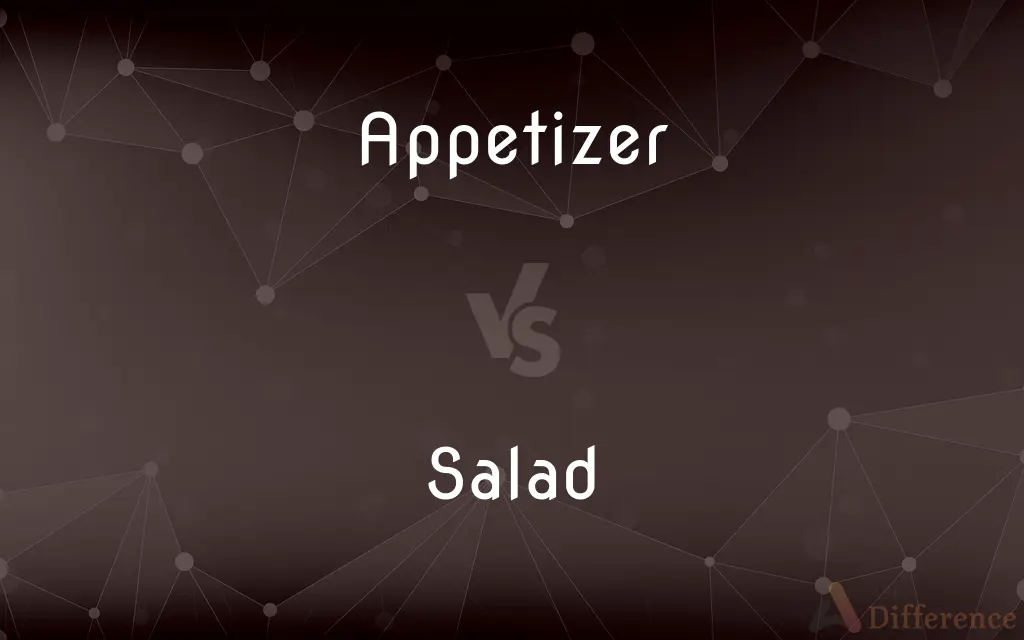Appetizer vs. Salad — What's the Difference?
Edited by Tayyaba Rehman — By Fiza Rafique — Updated on March 13, 2024
An appetizer is a small dish served before a meal to stimulate appetite, varying widely in ingredients and preparation. Salad is specific dish made of mixed greens, vegetables, and sometimes proteins, typically served as an appetizer, side, or main dish.

Difference Between Appetizer and Salad
Table of Contents
ADVERTISEMENT
Key Differences
Appetizers are designed to whet the appetite before the main course, offering a variety of flavors, textures, and ingredients, from soups to finger foods. Salads, on the other hand, specifically consist of mixed greens, vegetables, fruits, nuts, and sometimes proteins like chicken or fish, dressed with a vinaigrette or sauce.
While appetizers can be hot or cold, served in small portions to tease the palate without diminishing hunger, salads are usually served cold or at room temperature, providing a refreshing start or accompaniment to a meal. This difference in temperature and preparation broadens the appetizer category significantly beyond that of salads.
The purpose of appetizers is to introduce the meal and set the tone for the dining experience, incorporating a wide range of culinary styles and ingredients. Salads, however, often serve a dual role as a palate cleanser or a nutritious component of the meal, emphasizing fresh ingredients and simpler preparations.
Cultural variations influence the definition and components of appetizers significantly, ranging from tapas in Spain to dim sum in China. In contrast, salads maintain a more consistent identity across cultures, primarily focusing on raw vegetables and simple dressings, despite regional variations in ingredients.
Comparison Chart
Ingredients
Can include any food type
Primarily greens, vegetables, and sometimes proteins
ADVERTISEMENT
Serving Temperature
Hot or cold
Usually cold or room temperature
Purpose
Stimulate appetite, variety
Refresh, nourish, sometimes cleanse palate
Serving Size
Small portions
Can vary, often larger than appetizers
Cultural Variations
Wide range, significant differences
More consistent, with regional ingredient variations
Compare with Definitions
Appetizer
A small dish served before a meal to stimulate appetite.
Bruschetta is a popular appetizer in Italian cuisine.
Salad
A dish of mixed greens, vegetables, and sometimes proteins.
A Caesar salad often includes romaine lettuce and croutons.
Appetizer
Often includes a variety of flavors and textures.
Spring rolls offer a crispy appetizer option.
Salad
Served cold or at room temperature.
A chilled fruit salad is perfect for hot days.
Appetizer
Can be served hot or cold.
Chilled gazpacho makes a refreshing summer appetizer.
Salad
Typically dressed with vinaigrette or sauce.
A garden salad is enhanced by a light balsamic dressing.
Appetizer
Reflects a wide range of culinary styles.
Samosas are a flavorful appetizer in Indian cuisine.
Salad
Can be an appetizer, side, or main dish.
A hearty Cobb salad can serve as a fulfilling main course.
Appetizer
Introduces the meal and dining experience.
The shrimp cocktail appetizer set a luxurious tone for the dinner.
Salad
Emphasizes fresh ingredients.
A Caprese salad showcases fresh tomatoes and mozzarella.
Appetizer
A food or drink served usually before a meal to stimulate the appetite.
Salad
A salad is a dish consisting of mixed pieces of food, typically with at least one raw ingredient. They are often dressed, and typically served at room temperature or chilled, though some can be served warm.
Appetizer
A small, light, and usually savory first course in a meal
Salad
A dish of raw leafy green vegetables, often tossed with pieces of other raw or cooked vegetables, fruit, cheese, or other ingredients and served with a dressing.
Appetizer
Something that creates or increases excitement for what is to follow.
Salad
The course of a meal consisting of this dish.
Appetizer
Something which creates or whets an appetite.
Salad
A cold dish of chopped vegetables, fruit, meat, fish, eggs, or other food, usually prepared with a dressing, such as mayonnaise.
Appetizer
Food or drink to stimulate the appetite (usually served before a meal or as the first course)
Salad
A green vegetable or herb used in salad, especially lettuce.
Salad
A varied mixture
"The Declaration of Independence was ... a salad of illusions" (George Santayana).
Salad
A food made primarily of a mixture of raw or cold ingredients, typically vegetables, usually served with a dressing such as vinegar or mayonnaise.
Chicken salad
We'd like a couple of cheese salads and two Pepsis, please.
Salad
A raw vegetable of the kind used in salads.
Salad
(idiomatic) Any varied blend or mixture.
Salad
A preparation of vegetables, as lettuce, celery, water cress, onions, etc., usually dressed with salt, vinegar, oil, and spice, and eaten for giving a relish to other food; as, lettuce salad; tomato salad, etc.
Leaves eaten raw are termed salad.
Salad
A dish composed of chopped meat or fish, esp. chicken or lobster, mixed with lettuce or other vegetables, and seasoned with oil, vinegar, mustard, and other condiments; as, chicken salad; lobster salad.
Salad
Food mixtures either arranged on a plate or tossed and served with a moist dressing; usually consisting of or including greens
Common Curiosities
What is a salad?
A salad is a dish consisting of mixed greens, vegetables, fruits, and sometimes proteins, often dressed with a sauce or vinaigrette.
What distinguishes appetizers from salads?
Appetizers can include a broad range of dishes, from soups to finger foods, while salads are specifically made of greens and vegetables, sometimes with added proteins.
What is an appetizer?
An appetizer is a small dish served before a meal, intended to stimulate the appetite without satisfying hunger.
Can salads be a main course?
Yes, salads can be substantial enough, with added proteins and ingredients, to serve as a main course.
Do appetizers vary by culture?
Yes, appetizers vary significantly across cultures, reflecting local ingredients, culinary traditions, and dining practices.
What role do salads play in a meal?
Salads can serve as an appetizer, a palate cleanser, a nutritious side, or even a main dish, depending on their composition and the meal context.
Is there a specific way to serve appetizers?
Appetizers are usually served in small portions to avoid filling up diners before the main course, but the serving method can vary widely.
Can a salad be an appetizer?
Yes, a salad can be served as an appetizer, providing a light and refreshing start to a meal.
Are all appetizers served cold?
Not all appetizers are served cold; many are served hot, depending on the dish and culinary tradition.
What are common ingredients in a salad?
Common salad ingredients include leafy greens, raw vegetables, nuts, fruits, cheese, and sometimes grilled or cooked proteins.
How do appetizers fit into a meal?
Appetizers are served at the beginning of a meal to stimulate the appetite and introduce the flavors and theme of the meal.
Can appetizers be shared?
Many appetizers are designed for sharing, allowing diners to sample a variety of flavors before the main course.
Are salads always healthy?
While salads are often considered healthy due to their vegetable content, the nutritional value can vary based on ingredients and dressing.
How do you choose between an appetizer and a salad?
The choice between an appetizer and a salad depends on personal preference, dietary considerations, and the nature of the meal being served.
How important is dressing to a salad?
Dressing is crucial to most salads, adding flavor, moisture, and often acting as a binding agent for the ingredients.
Share Your Discovery

Previous Comparison
Yam vs. Yuca
Next Comparison
Pertinent vs. RelevantAuthor Spotlight
Written by
Fiza RafiqueFiza Rafique is a skilled content writer at AskDifference.com, where she meticulously refines and enhances written pieces. Drawing from her vast editorial expertise, Fiza ensures clarity, accuracy, and precision in every article. Passionate about language, she continually seeks to elevate the quality of content for readers worldwide.
Edited by
Tayyaba RehmanTayyaba Rehman is a distinguished writer, currently serving as a primary contributor to askdifference.com. As a researcher in semantics and etymology, Tayyaba's passion for the complexity of languages and their distinctions has found a perfect home on the platform. Tayyaba delves into the intricacies of language, distinguishing between commonly confused words and phrases, thereby providing clarity for readers worldwide.
















































